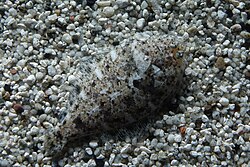Flatfish
Flatfish are a type of fish. There are several different kinds of flatfish. Some of them are fished commercially, like flounder, sole, turbot, plaice, and halibut.
| Flatfish | |
|---|---|

| |
| Flatfish (Peces planos) | |
| Scientific classification | |
| Kingdom: | |
| Phylum: | |
| Class: | |
| Infraclass: | |
| Order: | Pleuronectiformes (Flatfish)
|
| Families | |
|
Suborder Psettodoidei | |
All flatfish are rather flat, and are ray-finned fish. During their evolution, their eyes have moved so that they are on the same side, which the fish keeps uppermost. They swim like this, and can hide in the sand waiting for prey on the ocean floor. They have a capacity for dynamic camouflage, which is under nervous control, and can change in 'real time' to match their background.
The Order Pleuronectiformes is in the infraclass Teleostei. But it is best to look upon it as a group of fish which are adapted to the same habitat. They share those features which suit their life-style. They have both eyes on one side of the head: the upper side. This is their main adaptation to living on the seabed (benthos). Other distinguishing features are the protrusible eyes: they can stick the eyes up a bit to see round.
Evolution
The flatfish life-style or 'habit' evolved several times independently, and so the group is polyphyletic. Their young are perfectly symmetrical, but the head is remodelled during a metamorphosis. One eye moves to the other side, close to the other eye. Some species have both eyes on the left (turbot), some on the right (halibut, sole); all living and most fossil flatfish to date show an 'eyed' side and a 'blind' side.[1]
Charles Darwin predicted a gradual migration of the eye in evolution, mirroring the metamorphosis of the living forms. A recent examination of two fossil species from the Eocene shows "the assembly of the flatfish bodyplan occurred in a gradual, stepwise fashion".[2] The intermediate stages survived for quite a long time: over two geological stages. They are found in sites together with flatfish with the full cranial asymmetry. That shows the intermediate stages were at no particular disadvantage. Eventually, the more complete forms did survive. The evolution of flatfish falls squarely within the evolutionary synthesis.[1]
Amphistium is a 50-million-year-old fossil fish which has been identified as an early relative of the flatfish, and as a transitional fossil. In Amphistium, the transition from the typical symmetrical head of a vertebrate is incomplete, with one eye placed near the top-center of the head.[2] Paleontologists concluded that "the change happened gradually, in a way consistent with evolution by natural selection.
Today a large number of fish from various groups are flatfish. One report says over 800 species in 16 families of fish are flatfish.[3]
Flatfish Media
The European plaice is the principal commercial flatfish in Europe.
American soles are found in both freshwater and marine environments of the Americas.
Halibut are the largest of the flatfishes, and provide lucrative fisheries.
The turbot is a large, left-eyed flatfish found in sandy shallow coastal waters around Europe.
References
- ↑ 1.0 1.1 Janvier, Philip 2008. Squint of the fossil flatfish. Nature 454, 169
- ↑ 2.0 2.1 Friedman, Matt 2008. The evolutionary origin of flatfish asymmetry. Nature 454, 209–212.
- ↑ Campbell, Matthew A; Chanet, Bruno; Chen, Jhen‐Nien; Lee, Mao‐Ying; Chen, Wei‐Jen 2019. Origins and relationships of the Pleuronectoidei: Molecular and morphological analysis of living and fossil taxa. Zoologica Scripta 48 (5): 640–656. [1]